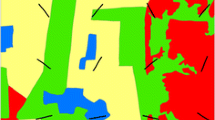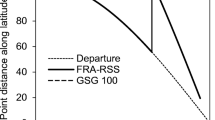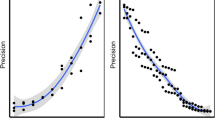Abstract
Spatial sampling design is one of the key steps in land cover accuracy assessment, and many traditional sampling approaches may not achieve credible spatial sampling due to the high spatial heterogeneity of land cover. This paper characterizes the spatial heterogeneity with three-level LSIs and determines the subsequent sample sizes and their spatial distributions. The three-level LSIs are rLSI in a region, cLSI for each land cover class and uLSI in each geographic sampling unit in the region. The rLSIs are used to derive appropriate sample sizes in the target regions. The cLSIs are used to assure that larger sample numbers are allocated to land cover classes with higher spatial heterogeneity. The uLSIs provide useful measures for selecting optimal geographic units in which sample sites will be located. This LSI-based sampling approach can derive the sample sizes and determine their distributions in an adaptive way according to the spatial heterogeneity. An experimental case study further demonstrates that the LSI-based sampling approach obtains more appropriate sample sizes for each region, sufficient sample numbers for rare classes, and optimal sample distributions in the geographical space.
Similar content being viewed by others
References
Ba H, Duffy C W, Ahouidi A D, Deh Y B, Diallo M Y, Tandia A, Conway D J. 2016. Widespread distribution of Plasmodium vivax malaria in Mauritania on the interface of the Maghreb and West Africa. Malar J, 15: 80
Ban Y, Gong P, Giri C. 2015. Global land cover mapping using Earth observation satellite data: Recent progresses and challenges. ISPRS-J Photogram Remote Sens, 103: 1–6
Brovelli M, Molinari M, Hussein E, Chen J, Li R. 2015. The first comprehensive accuracy assessment of GlobeLand30 at a national level: Methodology and results. Remote Sens, 7: 4191–4212
Cao X, Chen J, Chen L J, Liao A P, Sun F D, Li Y, Li L, Lin Z H, Pang Z G, Chen J, He C Y, Peng S. 2014. Preliminary analysis of spatiotemporal pattern of global land surface water. Sci China Earth Sci, 57: 2330–2339
Chen J, Ban Y F, Li S N. 2014a. China: Open access to Earth land-cover map. Nature, 514: 434–434
Chen J, Chen J, Liao A P, Cao X, Chen L J, Chen X H, He C Y, Han G, Peng S, Lu M, Zhang W W, Tong X H, Mills J. 2015. Global land cover mapping at 30 m resolution: A POK-based operational approach. ISPRS-J Photogramm Remote Sens, 103: 7–27
Chen J, Chen J, Liao A P, Chen L J, Chen X H, Peng S, Han G, Zhang H W, He C Y, Wu H, Lu M. 2014b. Concepts and key techniques for 30 m global land cover mapping. Acta Geod Carto Sin, 43: 551–557
Chen J, Dowman I, Li S, Li Z, Madden M, Mills J, Paparoditis N, Rottensteiner F, Sester M, Toth C, Trinder J, Heipke C. 2016. Information from imagery: ISPRS scientific vision and research agenda. ISPRS-J Photogram Remote Sens, 115: 3–21
Chen X, Yamaguchi Y, Chen J. 2012. Weighted misclassification rate: A new measure of classification error designed for landscape pattern index. Remote Sens Lett, 3: 57–65
Congalton R, Gu J, Yadav K, Thenkabail P, Ozdogan M. 2014. Global land cover mapping: A review and uncertainty analysis. Remote Sens, 6: 12070–12093
Foody G M, Boyd D S. 2013. Using volunteered data in land cover map validation: Mapping west African forests. IEEE J Sel Top Appl Earth Observations Remote Sens, 6: 1305–1312
Foody G M. 2002. Status of land cover classification accuracy assessment. Remote Sens Environ, 80: 185–201
Foody G M. 2009. Sample size determination for image classification accuracy assessment and comparison. Int J Remote Sens, 30: 5273–5291
Friedl M A, McIver D K, Hodges J C F, Zhang X Y, Muchoney D, Strahler A H, Woodcock C E, Gopal S, Schneider A, Cooper A, Baccini A, Gao F, Schaaf C. 2002. Global land cover mapping from MODIS: Algorithms and early results. Remote Sens Environ, 83: 287–302
Gao L L, Li X H, Wang C P, Qiu Q Y, Cui S H, Zhao Q J. 2010. Survey site selection based on the spatial sampling theory: A case study in Xiamen Island. J Geo-Inform Sci, 48: 358–364
García-Mozo H, Oteros J A, Galán C. 2016. Impact of land cover changes and climate on the main airborne pollen types in Southern Spain. Sci Total Environ, 548-549: 221–228
Han G, Chen J, He C, Li S, Wu H, Liao A, Peng S. 2015. A web-based system for supporting global land cover data production. ISPRS-J Photogramm Remote Sens, 103: 66–80
Herold M, Mayaux P, Woodcock C E, Baccini A, Schmullius C. 2008. Some challenges in global land cover mapping: An assessment of agreement and accuracy in existing 1 km datasets. Remote Sens Environ, 112: 2538–2556
Jin Y J, Du Z F, Jiang Y. 2015. Sampling Technique. 4th ed. Beijing: China Renmin University Press. 87
Karim M, Mimura N. 2008. Impacts of climate change and sea-level rise on cyclonic storm surge floods in Bangladesh. Global Environ Change, 18: 490–500
Li D, Zhang J, Wu H. 2012. Spatial data quality and beyond. Int J Geogr Inf Sci, 26: 2277–2290
Li L F, Wang J F, Liu J Y. 2005. Optimal decision-making model of spatial sampling for survey of China’s land with remotely sensed data. Sci China Ser D-Earth Sci, 48: 752–764
Liao A P, Chen L J, Chen J, He C Y, Cao X, Chen J, Peng S, Sun F D, Gong P. 2014. High-resolution remote sensing mapping of global land water. Sci China Earth Sci, 57: 2305–2316
Mayaux P, Eva H, Gallego J, Strahler A H, Herold M, Agrawal S, Naumov S, De Miranda E E, Di Bella C M, Ordoyne C, Kopin Y, Roy P S. 2006. Validation of the global land cover 2000 map. IEEE Trans Geosci Remote Sens, 44: 1728–1739
Niu Z G, Gong P, Cheng X, Guo J H, Wang L, Huang H B, Shen S Q, Wu Y Z, Wang X F, Wang X W, Ying Q, Liang L, Zhang L N, Wang L, Yao Q, Yang Z Z, Guo Z Q, Dai Y J. 2009. Geographical characteristics of China’s wetlands derived from remotely sensed data. Sci China Ser D-Earth Sci, 52: 723–738
Olofsson P, Foody G M, Herold M, Stehman S V, Woodcock C E, Wulder M A. 2014. Good practices for estimating area and assessing accuracy of land change. Remote Sens Environ, 148: 42–57
Olofsson P, Stehman S V, Woodcock C E, Sulla-Menashe D, Sibley A M, Newell J D, Friedl M A, Herold M. 2012. A global land-cover validation data set, part I: Fundamental design principles. Int J Remote Sens, 33: 5768–5788
Patton D R. 1975. A diversity index for quantifying habitat ‘edge’. Wildlife Soc Bull, 3: 171–173
Plexida S G, Sfougaris A I, Ispikoudis I P, Papanastasis V P. 2014. Selecting landscape metrics as indicators of spatial heterogeneity—A comparison among Greek landscapes. Int J Appl Earth Observ Geoinform, 26: 26–35
Pontius R G, Millones M. 2011. Death to Kappa: Birth of quantity disagreement and allocation disagreement for accuracy assessment. Int J Remote Sens, 32: 4407–4429
Ran Y H, Li X. 2015. First comprehensive fine-resolution global land cover map in the world from China—Comments on global land cover map at 30-m resolution. Sci China Earth Sci, 58: 1677–1678
Ruiz-Colmenero M, Bienes R, Eldridge D J, Marques M J. 2013. Vegetation cover reduces erosion and enhances soil organic carbon in a vineyard in the central Spain. Catena, 104: 153–160
Rutledge D. 2003. Landscape Indices As Measures of the Effect of Fragmentation: Can Pattern Reflect Process. Wellington: Department of Conservation. 14
Scepan J. 1999. Thematic validation of high-resolution global land-cover data sets. Photogramm Eng Remote Sens, 65: 1051–1060
See L, Perger C, Hofer M, Weichselbaum J, Dresel C, Fritz S. 2015. LACOWiki: An open access online portal for land cover validation. ISPRS Ann Photogramm Remote Sens Spatial Inf Sci, II-3/W5: 167–171
Smith J H, Stehman S V, Wickham J D. 2002. Impacts of patch size and land-cover heterogeneity on thematic image classification accuracy. Photogramm Eng Remote Sens, 68: 65–70
Stehman S V. 2009. Sampling designs for accuracy assessment of land cover. Int J Remote Sens, 30: 5243–5272
Stehman S V. 2012. Impact of sample size allocation when using stratified random sampling to estimate accuracy and area of land-cover change. Remote Sens Lett, 3: 111–120
Stehman S V, Olofsson P, Woodcock C E, Herold M, Friedl M A. 2012. A global land-cover validation data set, II: Augmenting a stratified sampling design to estimate accuracy by region and land-cover class. Int J Remote Sens, 33: 6975–6993
Strahler A H, Boschetti L, Foody G M, Friedl M A, Hansen M C, Herold M, Mayaux P, Morisette J T, Stehman S V, Woodcock C E. 2006. Global Land Cover Validation: Recommendations for Evaluation and Accuracy Assessment of Global Land Cover Maps. Luxembourg: European Communities. 51
Tong X H, Wang Z H, Xie H, Liang D, Jiang Z Q, Li J, Li J. 2011. Designing a two-rank acceptance sampling plan for quality inspection of geospatial data products. Comput Geosci, 37: 1570–1583
Wang J F, Christakos G, Hu M G. 2009a. Modeling spatial means of surfaces with stratified nonhomogeneity. IEEE Trans Geosci Remote Sens, 47: 4167–4174
Wang J F, Jiang C S, Hu M G, Cao Z D, Guo Y S, Li L F, Liu T J, Meng B. 2013. Design-based spatial sampling: Theory and implementation. Environ Modell Softw, 40: 280–288
Wang J F, Jiang C S, Li L F, Hu M G. 2009b. Spatial Sampling and Statistical Inference. Beijing: China science Publishing & Media Ltd. 21
Wang J F, Stein A, Gao B B, Ge Y. 2012. A review of spatial sampling. Spatial Stat, 2: 1–14
Wang Z H, Tong X H, Liang D, Xie H. 2010. Sampling inspection schemes for continuous lot spatial data. J Tongji Univ, 38: 749–752
Wu J G. 2001. Landscape Ecology: Pattern, Process, Scale and Hierarchy. 2nd ed. Beijing: High Education Press. 109
Zhao Y, Gong P, Yu L, Hu L, Li X, Li C, Zhang H, Zheng Y, Wang J, Zhao Y, Cheng Q, Liu C, Liu S, Wang X. 2014. Towards a common validation sample set for global land-cover mapping. Int J Remote Sens, 35: 4795–4814
Zhou W, Cadenasso M, Schwarz K, Pickett S. 2014. Quantifying spatial heterogeneity in urban landscapes: Integrating visual interpretation and object-based classification. Remote Sens, 6: 3369–3386
Zhu Z L, Yang L M, Stehman S V, Czaplewski R L. 2000. Accuracy assessment for the US geological survey regional land-cover mapping program: New York and New Jersey region. Photogramm Eng Remote Sens, 66: 1425–1438
Zimmerman P L, Housman I W, Perry C H, Chastain R A, Webb J B, Finco M V. 2013. An accuracy assessment of forest disturbance mapping in the western Great Lakes. Remote Sens Environ, 128: 176–185
Acknowledgements
This work was supported by the International S & T Cooperation Program of China (Grant No. 2015DFA11360) and the National Natural Science Foundation of China (Grant No. 41231172).
Author information
Authors and Affiliations
Corresponding author
Rights and permissions
About this article
Cite this article
Chen, F., Chen, J., Wu, H. et al. A landscape shape index-based sampling approach for land cover accuracy assessment. Sci. China Earth Sci. 59, 2263–2274 (2016). https://doi.org/10.1007/s11430-015-5280-5
Received:
Accepted:
Published:
Issue Date:
DOI: https://doi.org/10.1007/s11430-015-5280-5




